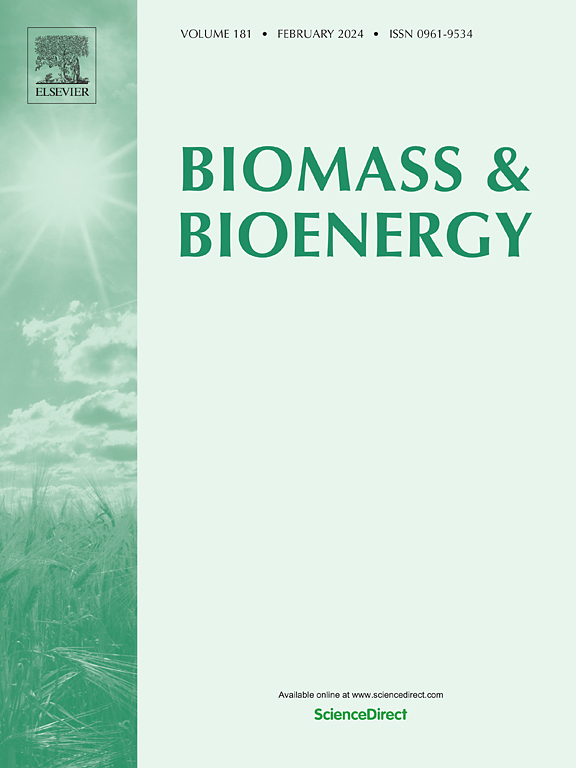葡萄酒工业木质纤维素残渣共热解的协同效应和动力学:迈向低碳经济的废物转化为生物燃料的例子
IF 5.8
2区 生物学
Q1 AGRICULTURAL ENGINEERING
引用次数: 0
摘要
葡萄酒行业产生大量的木质纤维素废料,通过共热解生产生物燃料的潜力。本文研究了葡萄秸秆(GS)、红酒酿造葡萄渣(GPW)和grappa酿造葡萄渣(GPG)的二元和三元共热解行为,以优化能量回收。对生物量进行了表征,包括成分、近似值、最终值、体积密度和高热值分析。在热重分析仪中,分别在5、10、20和30°C min - 1下对单个残留物及其混合物进行热解。分别用Kissinger- akahira - sunose等转换法和Kissinger法估算了活化能Ea和指数前因子A。通过比较固体残渣质量(W)和Ea的理论值与实验值来评价协同效应。平均Ea在190.25 ~ 233.13 kJ mol−1之间,A在4.76 ~ 4.26 × 1020 min−1之间。三元混合物通过降低Ea,降低热分解能垒,增强反应的可行性,表现出正向的协同效应。相比之下,二元混合物表现出负协同作用,其Ea值高于单个残留物。值得注意的是,GS + GPG混合物在W、Tmax和分解率方面表现出正协同作用。这些发现表明,共同处理葡萄酒酿造残留物可能既有有益的影响,也有不利的影响,这取决于组合。研究结果强调了这种农业工业废弃物作为有价值的生物燃料原料的未开发潜力,并提供了一种简化、实用的工业利用方法,可持续有机残留物管理符合循环经济原则。本文章由计算机程序翻译,如有差异,请以英文原文为准。

Synergistic effect and kinetics of co-pyrolysis of lignocellulosic residues from the winemaking industry: A waste-to-biofuel conversion example toward a low-carbon economy
The wine industry generates substantial lignocellulosic waste with potential for biofuel production via co-pyrolysis. This study investigates the co-pyrolysis behavior of winemaking residues, including grape stalks (GS), grape pomace from red winemaking (GPW), and grape pomace from grappa production (GPG), in binary and ternary combinations, with the aim of optimizing energy recovery. The biomasses underwent characterization, including compositional, proximate, ultimate, bulk density, and higher heating value analyses. The pyrolysis of the individual residues and their mixtures was conducted in a thermogravimetric analyzer at 5, 10, 20, and 30 °C min−1. The activation energy (Ea) and the pre-exponential factor (A) were estimated using the Kissinger-Akahira-Sunose isoconversional and the Kissinger methods, respectively. Synergistic effects were assessed by comparing theoretical values of solid residue mass (W) and Ea, with experimental values. The average Ea ranged between 190.25 and 233.13 kJ mol−1, with A between 4.76 × 1016 and 4.26 × 1020 min−1. The ternary mixture exhibited a positive synergistic effect by reducing Ea, lowering the energy barrier for thermal decomposition, and enhancing the reaction's feasibility. In contrast, binary mixtures exhibited a negative synergy, with higher Ea values than individual residues. Notably, the GS + GPG mixture exhibited a positive synergy in terms of W, Tmax, and decomposition rates. These findings show that co-processing winemaking residues can have both beneficial and adverse effects, depending on the combination. The results highlight the untapped potential of this agro-industrial waste as valuable biofuel feedstocks and offer a simplified, practical approach for industrial use, with sustainable organic residue management aligned with circular economy principles.
求助全文
通过发布文献求助,成功后即可免费获取论文全文。
去求助
来源期刊

Biomass & Bioenergy
工程技术-能源与燃料
CiteScore
11.50
自引率
3.30%
发文量
258
审稿时长
60 days
期刊介绍:
Biomass & Bioenergy is an international journal publishing original research papers and short communications, review articles and case studies on biological resources, chemical and biological processes, and biomass products for new renewable sources of energy and materials.
The scope of the journal extends to the environmental, management and economic aspects of biomass and bioenergy.
Key areas covered by the journal:
• Biomass: sources, energy crop production processes, genetic improvements, composition. Please note that research on these biomass subjects must be linked directly to bioenergy generation.
• Biological Residues: residues/rests from agricultural production, forestry and plantations (palm, sugar etc), processing industries, and municipal sources (MSW). Papers on the use of biomass residues through innovative processes/technological novelty and/or consideration of feedstock/system sustainability (or unsustainability) are welcomed. However waste treatment processes and pollution control or mitigation which are only tangentially related to bioenergy are not in the scope of the journal, as they are more suited to publications in the environmental arena. Papers that describe conventional waste streams (ie well described in existing literature) that do not empirically address ''new'' added value from the process are not suitable for submission to the journal.
• Bioenergy Processes: fermentations, thermochemical conversions, liquid and gaseous fuels, and petrochemical substitutes
• Bioenergy Utilization: direct combustion, gasification, electricity production, chemical processes, and by-product remediation
• Biomass and the Environment: carbon cycle, the net energy efficiency of bioenergy systems, assessment of sustainability, and biodiversity issues.
 求助内容:
求助内容: 应助结果提醒方式:
应助结果提醒方式:


